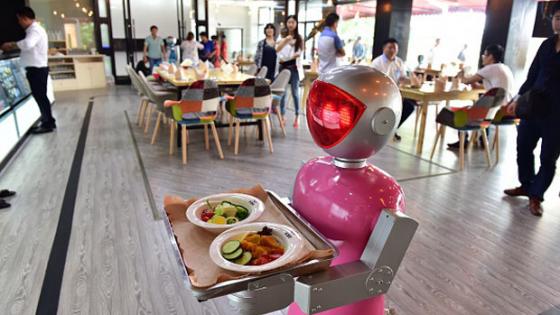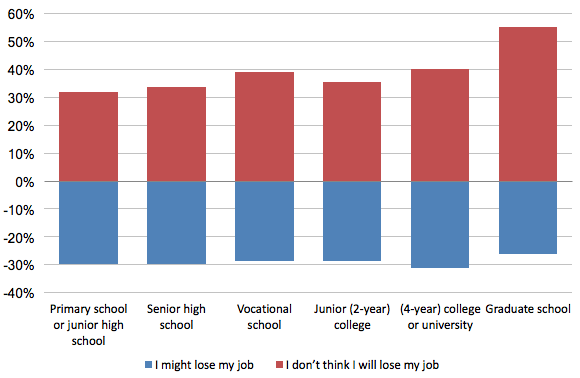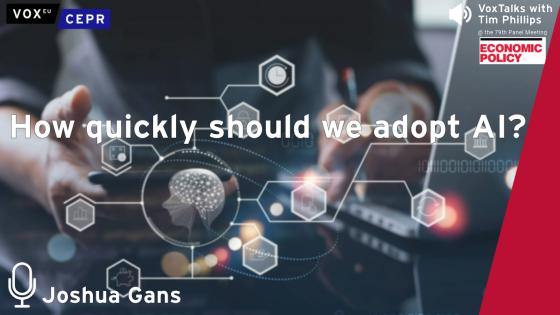Amid the stagnant productivity and potential growth rates in major advanced economies, policymakers expect the Fourth Industrial Revolution and its technologies, including artificial intelligence (AI) and robotics, to drive future economic growth. In Japan, Investments for the Future Strategy 2017, the latest growth strategy of the Shinzo Abe Cabinet, places the Fourth Industrial Revolution as the top priority for growth promotion policies. On the other hand, the negative impacts of AI and robotics, especially loss of human jobs, have been actively discussed around the world.
Impact of AI and robots on human jobs
According to an influential study by Frey and Osborne (2017), about 47% of total US employment faces the risk of being computerised. Their study attracted attention not only from researchers, but also policymakers around the world. David (2017) applies a similar methodology to Japan to estimate that 55% of employment is susceptible to being replaced by computers. On the other hand, Arntz et al. (2016), taking a task-based approach, estimate that the share of automatable jobs in the 21 OECD countries is only 9%, which is far smaller than the figure derived from the occupation-based approach employed by Frey and Osborne (2017). The point of their task-based study is that some of the tasks contained in high-risk occupations cannot be easily computerised. In addition, computers and robots may create new products and services, and these product innovations will result in currently unimaginable new occupations (Mokyr et al. 2015). Furthermore, new automation technologies and some types of labour are highly complementary (Autor 2015).
In spite of widespread interest in the impact of AI and robotics on the labour market, studies in economics are still in the initial stages and quantitative empirical studies have been limited. A major reason for this delay is the lack of statistical data on AI and robotics, as the technologies are in the phase of development and early diffusion. A possible approach to overcoming the lack of statistical data is to conduct surveys on firms or individuals to collect subjective assessment of the impacts of these new technologies. A recent example of this line of study is Morikawa (2017a), in which I conducted a survey of a large number of Japanese firms to analyse the possible impact of AI and robotics on employment. The study detects technology-skill complementarity at the firm level. In particular, the complementarity with AI-related technologies is more prominent for employees with postgraduate education. However, the individual characteristics used in the analysis are limited and aggregated at the firm level.
A new survey on individuals
Against this backdrop, I conducted an original survey on Japanese individuals to present new evidence on the possible impacts of AI and robotics on employment (Morikawa 2017b). The major interests of this study are the type of individuals concerned about losing their jobs, and what type of jobs are likely to be replaced by the development and diffusion of AI and robotics. To be more specific, I analysed the relationship between various individual characteristics (e.g. age, educational attainment, and occupation) and their perception of the impact of AI and robotics on their own employment prospects. The main hypothesis of this study is that highly skilled individuals tend to perceive the impact of AI and robotics positively, and vice versa. I distinguished malleable/adaptable general skills formed through higher education and occupation-specific skills acquired from vocational schooling or embodied as possessing occupational licenses.
The data used in the study originate from the ‘Survey of Life and Consumption Under the Changing Economic Structure and Policies’, which I designed and was conducted by the Research Institute of Economy, Trade and Industry (RIETI) in 2016 with exactly 10,000 respondents. The specific questionnaire regarding the impact of AI and robotics is: “What do you think about the impact of AI and robotics on the future of your job?”. The choices to answer this question are: 1) “I might lose my job”, 2) “I don’t think I will lose my job”, and 3) “I don’t know”. The methods of analysis are simple cross-tabulations by individual characteristics and ordered-probit estimations. The individual characteristics include gender, age, education, industry, type of employment, and occupation.
Who is afraid of losing their job?
According to the analysis, about 30% of people believe there is a risk of their job being replaced by AI and robotics. By age classes, younger generations (those in their 20s and 30s) tend to perceive a risk of losing their jobs (Figure 1). This is a natural result, as the development and diffusion of AI and robotics will be advancing gradually. By education, workers with postgraduate education are least pessimistic about the prospect of their job, followed by university graduates and those who graduated from vocational school (Figure 2).
Figure 1 Impact of AI and robotics on employment by age
Note: Calculated from the “Survey of Life and Consumption Under the Changing Economic Structure and Policies.” Sample comprises those who are currently working (N=6,579).
Figure 2 Impact of AI and robotics on employment by education
Note: Calculated from the “Survey of Life and Consumption Under the Changing Economic Structure and Policies.” Sample comprises those who are currently working (N=6,579).
The ordered-probit estimation to explain risk perception by a wide range of individual characteristics confirms the cross-tabulation result that those who have postgraduate education are less likely to perceive their jobs to be at risk. Although the coefficient for university education is statistically insignificant, the coefficient for natural science majors is positive and significant. A natural interpretation is that those who studied natural sciences in higher education have better analytical skills, which are less likely to be replaced by the new technologies. Interestingly, the coefficient for vocational schooling is positive and significant. These people perceive that their occupation-specific skills, which are not necessarily numerical or analytical, cannot be easily substituted by AI and robotics.
Further, those who possess and use occupational licenses in their current job perceive the risk of losing their job to be lower. One interpretation is that the holding of occupational licenses reflects high-level, occupation-specific skills. Since consumers’ preference for services provided by human workers is strong in currently human-intensive services such as childcare, healthcare, and education, those who are working in these occupations may recognise the importance of human contact and perceive the risk of substitution to be small. Another possibility is that the labour markets of licensed occupations are protected by laws and regulations and the restrictions on new entry leads to monopolistic powers for the incumbents.
By type of employment, the coefficients for part-time employees, temporary agency workers, and entrusted employees are negative and statistically significant. On the other hand, the subjective risk of company executives and the self-employed is statistically indistinguishable from that of regular employees. The result of the non-regular employees’ higher subjective risk perception is consistent with the results of the study by David (2017), which assesses the risk of job destructions induced by computer technology in Japan from a technical viewpoint.
Concluding remarks
The results suggest that malleable/adaptable skills acquired through higher education, particularly in science and engineering, are complementary with new technologies such as AI and robotics. At the same time, occupation-specific skills acquired by attending professional schools or holding occupational licenses, particularly those related to human-intensive personal services, are not easily replaced by AI and robotics. From a policy perspective, investments in developing malleable high-level skills through postgraduate education and personal skills specific to human-intensive services are both important.
Editors’ note: The main research on which this column is based first appeared as a Discussion Paper of the Research Institute of Economy, Trade and Industry (RIETI) of Japan.
References
Arntz, M, T Gregory, and U Zierahn (2016), “The Risk of Automation for Jobs in OECD Countries: A Comparative Analysis”, OECD Social, Employment and Migration Working Paper, no. 189.
Autor, D H (2015), “Why Are There Still So Many Jobs? The History and Future of Workplace Automation”, Journal of Economic Perspectives 29(3): 3-30.
David, B (2017), “Computer Technology and Probable Job Destructions in Japan: An Evaluation”, Journal of the Japanese and International Economies 43: 77-87.
Frey, C B, and M A Osborne (2017), “The Future of Employment: How Susceptible Are Jobs to Computerisation?”, Technological Forecasting & Social Change 114: 254-280.
Mokyr, J, C Vickers, and N L Ziebarth (2015), “The History of Technological Anxiety and the Future of Economic Growth: Is This Time Different?”, Journal of Economic Perspectives 29(3): 31-50.
Morikawa, M (2017a), “Firms’ Expectations about the Impact of AI and Robotics: Evidence from a Survey”, Economic Inquiry 55(2): 1054-1063.
Morikawa, M (2017b), “Who Are Afraid of Losing Their Jobs to Artificial Intelligence and Robots? Evidence from a Survey”, RIETI Discussion Paper, 17-E-069.






